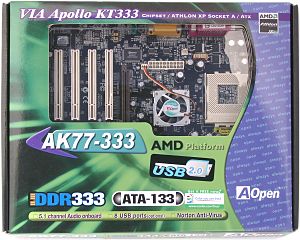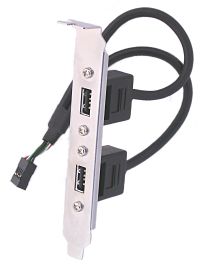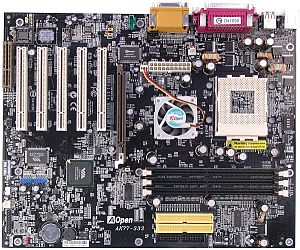
Black color of the textolite excellently matches with good functional
capabilities (first of all, I mean the USB 2.0 controller) and set of accessories.
Accessories:
- Package of a standard design with a cutout and a plastic package instead
of a antistatic cover;
- Documentation: a user manual and a colorful poster with brief installation
instructions - in English;
- Cables: 1 ATA66/100/133, 1 ATA33 and 1 FDD;
- Bracket with 2 USB ports;

- AOpen club registration card;
- 2 CDs with software:
- drivers;
- user manual in PDF;
- Adobe Acrobat Reader;
- DocuCom Reader;
- 3Deep E-Color;
- Norton Antivirus 2002;
- Norton CrashGuard 1.0;
- system monitoring utility;
- AOpen AOConfig (system information);
- DirectX 8.1.

The layout is quite convenient, but there are still some insignificant
flaws: audio-ins and a power connector are put in between the AGP slot
and the rear panel's unit. It's not difficult to reach jumpers and switches
even
when the board is already installed. Their functions are shown on the textolite.
The 3-channel switching voltage regulator incorporates 3 capacitors
of 3300 uF and 4 of 2200 uF.
The following controllers are integrated:
- audio controller based on the Avance Logic ALC650 AC'97 codec with a connector
for front audio-outs and support of acoustic systems 5.1;
- USB 2.0 bus controller based on the VIA VT6202 bus.
The board supports the following proprietary technologies: Dr.LED (to display
information on the POST procedure - the board has a connector - for a bracket
with LEDs for a 5" bay) and Die-Hard BIOS (BIOS recovery - the board provides
a panel for the 2nd Flash EEPROM chip and a connector for switching modes
of this function).
Non-unsoldered connectors: none.
The system monitoring is supported by the Winbond W83697HF chip. What
is controlled:
- voltage of processor, +3.3, +5 and +/-12 V, VBAT and +5 B Standby;
- speed of 2 fans;
- temperatures of the processor (thermodiod in processor socket) and the board (a built-in
sensor).
There are 2 connectors for adjustable connection of fans and 1 for non-adjustable
connection (for a fan on a heatsink of the chipset's north bridge).
Brief characteristics of the board: memory slots - 3 DDR SDRAM;
expansion slots - AGP/ 5 PCI/ CNR; I/O ports - 2 COM/ LPT/ 2 PS/2/ 4 USB
1.1/ 4 USB 2.0; dimensions - 305x245 mm.
Adjustment can be carried out with:
| jumpers and switches |
Jumper to clear up the CMOS |
 |
| Jumper to choose a FSB frequency |
100 and 133 MHz |
| Switches to change a CPU multiplier |
Auto, x5.5 - x12.5 |
| Jumper to set the Die-Hard BIOS mode |
Normal/Rescue |
| BIOS based on the ver.6.00PG from Award |
Setup of memory timings |
+ |
CAS Latency, Burst Length, Queue Depth, Command Rate |
| Setup of memory frequency |
+ |
PCI Clock x3, x4, x5 |
| Setup of AGP bus |
+ |
 |
| Setup of PCI bus |
+ |
 |
| Changeable scaler of AGP and PCI buses |
- |
 |
| Manual assignment of interrupts |
- |
 |
| Changeable FSB frequency |
+ |
100-248 MHz in 1 MHz steps |
| Changeable CPU multiplier |
+ |
x5.5-x12.5 |
| Changeable core voltage |
+ |
1.1-1.85 V in 0.05V steps |
| Changeable memory voltage |
- |
 |
| Changeable chipset voltage |
- |
 |
| Changeable AGP bus voltage |
- |
 |
We used the latest available version of the BIOS - 1.02.
Lack of a great overclocking potential (though the required
minimum is provided) is made up for by high quality of the board; besides, such
products are positioned for another market - not for extremal users but for those
who consider stability and functionality more important.
Test results:
Write a comment below. No registration needed!



